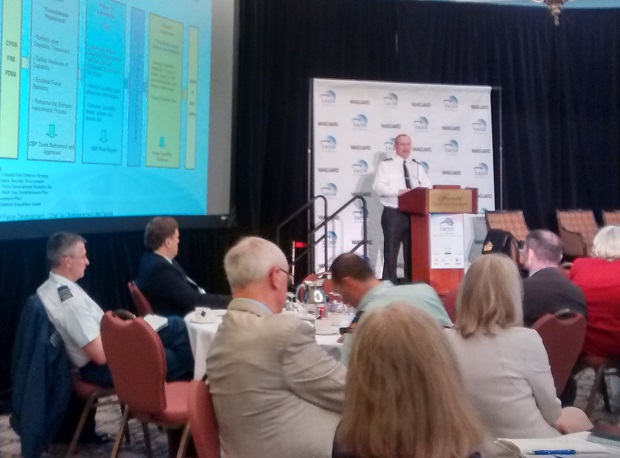Canadian defence industry companies got a rare and candid view of the military’s C4ISR goals for the near future during the C4ISR and Beyond 2016 event held in Ottawa on Wednesday by Vanguard Magazine.
No less than Rear-Admiral D. C. Hawco, MSM, CD, Chief of Force Development, was among the lineup of senior military officers who discussed the communications, surveillance, intelligence and control needs of various services of the armed forces.
C4ISR stands for command, control, communications, intelligence, surveillance, and reconnaissance. It is a military concept that combines all systems that allow commanders to understand their operational environment, control assets and identify mission critical factors.
“Resilience and security of the supply chain integrity are critical factors in our C4ISR programs,” Hawco said during his keynote address, The CAF C4ISR Strategic Vision. “…We need to achieve a fine balance between interoperability, affordability and mission assurance.”
(Vanguard will be providing additional videos, podcasts and articles about C4ISR and Beyond 2016 in the next few days)
The admiral provided the more than 100 attendees a brief overview of the CAF’s existing and future programs that are directly connected with C4ISR. He also laid out the military’s C4ISR objectives which included:
- Securing the military communications and computer networks
- Enhancing interoperability and connectivity of systems
- Connecting tactical data links to joint forces and multinational operations
- Enabling mission specific command and control
- Deploying persistent surveillance and reconnaissance systems
Army Col. Sean Sullivan, director of land command and information, took part in a couple panels. One of them, which dealt with how C4ISR will enable military operations in the next decade, was moderated by Lt. Col. Stephen Parsons, CD, SSO Strategy, DC4ISR. The other tackled mission-ready communications and satellite communications, which was moderated by Aaron Brosnan, vice-president of Business Development for Thales Defence and Security Inc.
Sullivan said the three main C4ISR challenges faced by land forces commanders and soldiers in the battlefield are:
- Complexity of the land battlespace and the facilitation of exchange of information between troops on the ground and HQ, as well as the exchange of information among soldiers in the battlefield
- Technical complexity of networks
- The rate of technology change and the ability of operators to keep up-to-date on emerging technology
“This event provided us with an excellent opportunity to understand what the military needs,” Brosnan told Vanguard. “It gave us an opportunity to get their point of view about C4ISR technology and how it really impacts their operations and personnel.”
“The opportunity for networking is unmatched,” said Brent Perrott, president of Hunter Communications Canada, who was part of the panel on mission-ready communications. “I have never been to any event such as this where so many military decision makers are present in one room at the same time.”
Also discussed during the event were C4ISR coordination needs in the North. This panel was moderated by Brig. Gen. Michel Lalumiere, director general of Space. Panelists were Col. (Ret’d) Andre Dupuis, president of Space Strategies Consulting Ltd., and Jack Rigley, director of new satellite systems development for Telesat.
Col. (Ret’d) Pierre LeBlanc, president of Arctic Security Consultants, moderated the discussion on Arctic and maritime surveillance. Gregory Lick, director general of operations for the Canadian Coast Guard, discussed the evolving role and responsibilities of the CCG in a time that the unprecedented melting of the polar ice cap is opening up the Canadian Arctic to an ever growing traffic of sea vessels.
Col. Sullivan, Commander Mike Mangin, CD, directorate of Naval requirements, and Col Francoise Beaupre, CD, directorate of Air domain development, were panelists during the discussion of how C4ISR will enable military operations in the next decade.


Comments are closed.